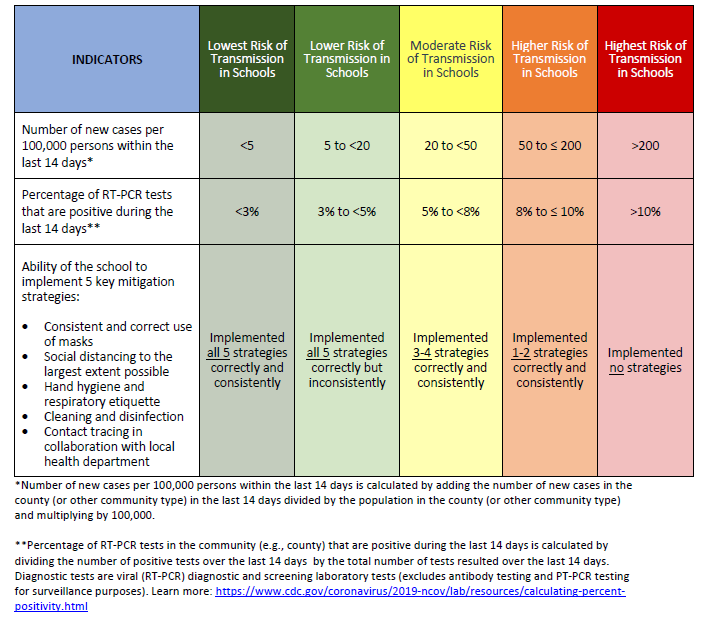
The CDC has released indicators to help schools make dynamic decisions about in-person learning as local conditions evolve throughout the pandemic. When coupled with local data about community spread, these indicators are an important tool to help local health officials, school administrators, and communities prepare, plan, and respond to COVID-19. These indicators are the latest resources CDC has provided for schools during the COVID-19 pandemic, and they supplement previously released CDC guidance.
To make decisions about operational conditions, like beginning, continuing, or pausing in-person learning, schools in cooperation with local health departments must be able to monitor the local spread of COVID-19 and assess their own ability to implement prevention and mitigation strategies for students, teachers, and staff. This new resource includes core and secondary indicators to help local officials and school districts assess their risk for COVID-19 introductions into and spread within their schools. The indicators reflect the mutually dependent relationship between schools and their surrounding communities. The measures do not set strict cutoffs for individual schools and school systems; they should be used as guideposts for monitoring local conditions and adjusting teaching models as needed.
Whether at higher or lower risk, schools and local officials are encouraged to use the indicators, existing guidance, and other available information as they prepare for a return to or the continuation of in-person learning, implement plans for safer operations, and quickly respond to COVID-19 cases and threats.
Indicators: Number of new cases per 100,000 persons within the last 14 days*
- Lowest Risk of Transmission: <5
- Lower Risk of Transmission: 5 to <20
- Moderate Risk of Transmission in Schools: 20 to <50
- Higher Risk of Transmission in Schools: 50 to ≤200
- Highest Risk of Transmission in Schools: >200
Indicators: Percentage of RT-PCR test that are positive during the last 14 days**
- Lowest Risk of Transmission: <3%
- Lower Risk of Transmission: 3% to <5%
- Moderate Risk of Transmission in Schools: 5% to <8%
- Higher Risk of Transmission in Schools: 8% to ≤10%
- Highest Risk of Transmission in Schools: >10%
Indicators: Ability of the school to implement 5 key mitigation strategies:
- Consistent and correct use of masks
- Social distancing to the largest extent possible
- Hand hygiene and respiratory etiquette
- Cleaning and disinfection
- Contact tracing in collaboration with local health department
- Lowest Risk of Transmission: Implemented all 5 strategies correctly and consistently
- Lower Risk of Transmission: Implemented all 5 strategies correctly but inconsistently
- Moderate Risk of Transmission in Schools: Implemented 3-4 strategies correctly and consistently
- Higher Risk of Transmission in Schools: Implemented 1-2 strategies correctly and consistently
- Highest Risk of Transmission in Schools: Implemented no strategies
*Number of new cases per 100,000 persons within the last 143 days is calculated by adding the number of new cases in the county (or other community type) in the last 14 days divided by the population in the county (or other community type) and multiplying by 100,000.
**Percentage of RT-PCR tests in the community (e.g., county that are positive during the last 14 days is calculated by dividing the number of positive test over the last 14 days by the total number of test resulted over the last 14 days. Diagnostic tests are viral (RT-PCR) diagnostic and screening laboratory tests (excludes antibody testing and PT-PCR testing for surveillance purposes). Learn more: https://www.cdc.gov/coronavirus/2019-ncov/lab/resources/calculating-percent-positivity.html


Chattooga Local News
Nurse’s Intuition Ensured Stroke Victim Received Quick Care

Chattooga Local News
Beat the Heat: Signs of Dehydration and When to Use Virtual Primary Care

Bulloch Public Safety
06/09/2025 Booking Report for Bulloch County

Bulloch Public Safety
06/23/2025 Booking Report for Bulloch County

Bulloch Public Safety
06/30/2025 Booking Report for Bulloch County

Bulloch Public Safety
06/16/2025 Booking Report for Bulloch County

Bulloch Public Safety
06/19/2025 Booking Report for Bulloch County







